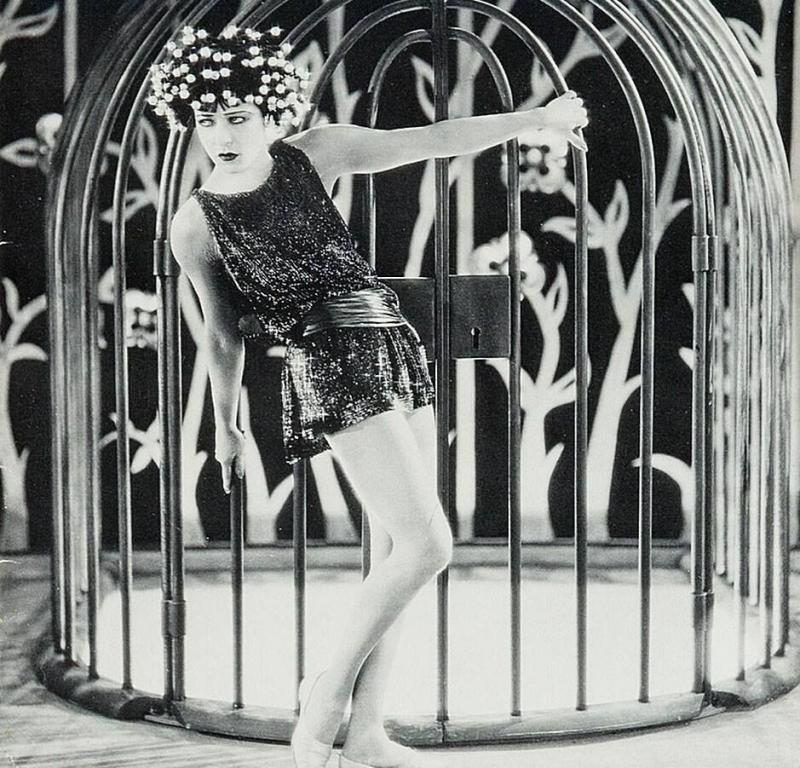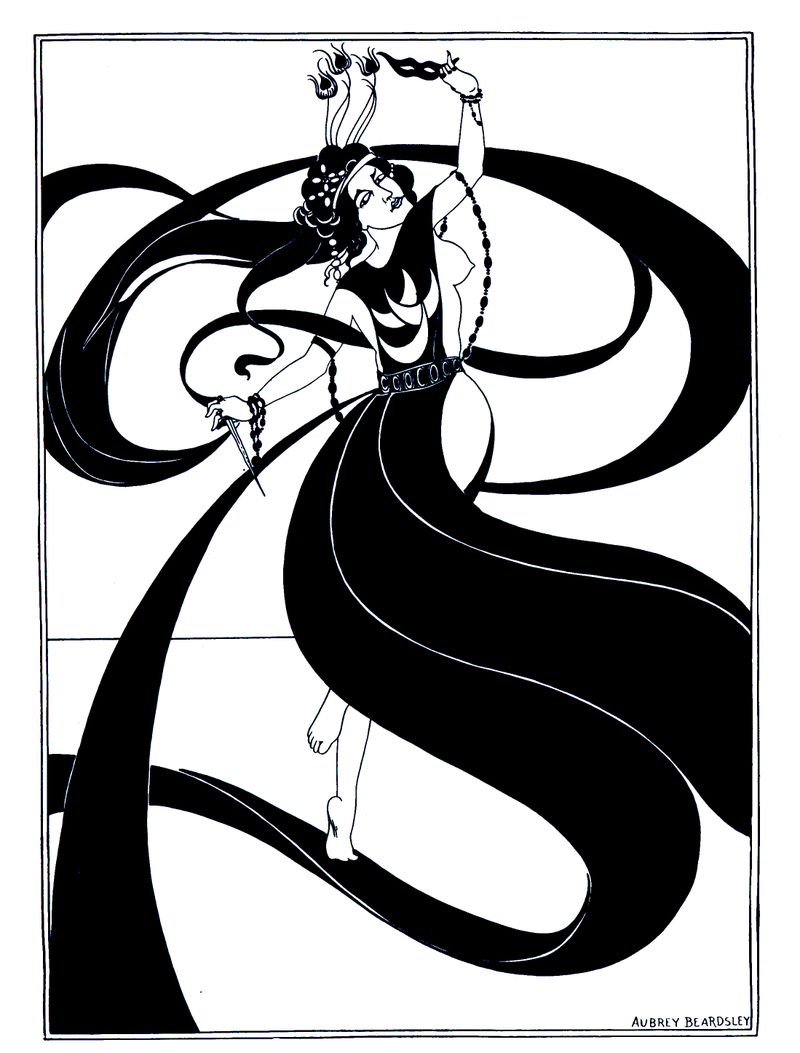Haley Fohr: Salomé, Brighton Festival 2019 review – potently camp debauch | reviews, news & interviews
Haley Fohr: Salomé, Brighton Festival 2019 review – potently camp debauch
Haley Fohr: Salomé, Brighton Festival 2019 review – potently camp debauch
Infamous Wilde silent film adaptation scored live and reconsidered

Haley Fohr’s disquiet at the “wildly outmoded” sexual politics of this notorious 1923 Wilde adaptation led her to cut its intertitles, relying only on sometimes delirious imagery and her throbbing live score.
The Jewish-Russian émigré was a major Broadway and Hollywood star when her uncompromising, ruinously expensive vision for Salomé, and the scandal of her fake marriage to its director Charles Bryant, bankrupted her production company and all but finished her film career. Fohr helps a substantial audience at Hove’s The Old Market relish it rather more.
Anyone wondering whether Herod’s outrageously effeminate, nipple-painted guards were accidental proto-camp is pointed towards its makers’ lives. Producer-star and pseudonymous screenwriter Nazimova held lesbian court in the Hollywood Hills with lovers including Oscar’s niece Dolly Wilde and, it was rumoured, Salomé’s costume designer – and Valentino’s wife – Natacha Rambova. Scandalmonger Kenneth Anger’s assertion that the whole cast was gay seems credible, and men play female courtiers. Queen Herodias’s male favourite, dryly supplying booze and sympathy, suggests George Sanders. But Salomé’s reputation for practically inventing camp proves its least interesting aspect.
 Chicagoan Fohr, aka Circuit Des Yeux (pictured above), pulls synth sounds from a circuit-board as her voice plumbs androgynous, lugubrious depths, in an otherwise acoustic band of viola, double-bass and drums. There’s a prevailing sense of ominous pressure in a score whose performance never overwhelms the film. It would frankly be hard to, as the first gauzy veil parts to reveal Rambova’s spectacular costumes, inspired by Aubrey Beardsley’s illustrations to Wilde’s play and her fascination with Egyptology. We are visually somewhere between the Naughty Nineties and Roaring Twenties, Pharaoh’s court and a Flash Gordon serial.
Chicagoan Fohr, aka Circuit Des Yeux (pictured above), pulls synth sounds from a circuit-board as her voice plumbs androgynous, lugubrious depths, in an otherwise acoustic band of viola, double-bass and drums. There’s a prevailing sense of ominous pressure in a score whose performance never overwhelms the film. It would frankly be hard to, as the first gauzy veil parts to reveal Rambova’s spectacular costumes, inspired by Aubrey Beardsley’s illustrations to Wilde’s play and her fascination with Egyptology. We are visually somewhere between the Naughty Nineties and Roaring Twenties, Pharaoh’s court and a Flash Gordon serial.
Nazimova’s Salomé is first seen in a glittering flapper dress with lit baubles in her frizzed brunette hair, and later with the wild blonde bob of an electrocuted pageboy. A slip of a woman with a dancer’s litheness, her heavy-lidded petulance rarely seems seductive. Herod, played by Mitchell Lewis as a toad-like Capone, responds anyway. So does John the Baptist, briefly, as Salomé hangs from his cage with a cat’s intent, and strokes him as a brazier’s hell-smoke rises behind them. More naked than Salomé in his loincloth, John seems priggish more than noble as he rejects her.
 Critics thought Salomé slow even in 1923. But the climactic Dance of the Seven Veils lays waste to the languor. Fohr gives a mighty howl mixing power and anguish, drums pound, and on-screen brass-playing dwarves and false-bearded wise men are equally, lasciviously transfixed. Salomé spins, abandoned, then rises under a veil like a ghost. The music’s low moan hovers between sacred and unholy ritual. It falls silent as Salomé’s perverse but serious, almost sorrowful lust sees her kill its saintly object. She rises from the cell with a shield as a basket for the Baptist’s head, and a Beardsley-esque conjurer’s cloak (Beardsley's Salome, pictured right). In a theme which would define the Twenties, the debauch has gone too far.
Critics thought Salomé slow even in 1923. But the climactic Dance of the Seven Veils lays waste to the languor. Fohr gives a mighty howl mixing power and anguish, drums pound, and on-screen brass-playing dwarves and false-bearded wise men are equally, lasciviously transfixed. Salomé spins, abandoned, then rises under a veil like a ghost. The music’s low moan hovers between sacred and unholy ritual. It falls silent as Salomé’s perverse but serious, almost sorrowful lust sees her kill its saintly object. She rises from the cell with a shield as a basket for the Baptist’s head, and a Beardsley-esque conjurer’s cloak (Beardsley's Salome, pictured right). In a theme which would define the Twenties, the debauch has gone too far.
Nazimova’s Salomé is at her most potent as horrified guards destroy her, Herod flees, drums hammer as if forcing entry in a nightmare, and Fohr’s electronics roil. Her cutting of Nazimova’s script is a debatable feminist act. But misogyny and murder do coalesce into female power, in our final sight of this film’s astonishing maker.
rating
Explore topics
Share this article
The future of Arts Journalism
You can stop theartsdesk.com closing!
We urgently need financing to survive. Our fundraising drive has thus far raised £49,000 but we need to reach £100,000 or we will be forced to close. Please contribute here: https://gofund.me/c3f6033d
And if you can forward this information to anyone who might assist, we’d be grateful.

Subscribe to theartsdesk.com
Thank you for continuing to read our work on theartsdesk.com. For unlimited access to every article in its entirety, including our archive of more than 15,000 pieces, we're asking for £5 per month or £40 per year. We feel it's a very good deal, and hope you do too.
To take a subscription now simply click here.
And if you're looking for that extra gift for a friend or family member, why not treat them to a theartsdesk.com gift subscription?
more Film
 Can I get a Witness? review - time to die before you get old
Ann Marie Fleming directs Sandra Oh in dystopian fantasy that fails to ignite
Can I get a Witness? review - time to die before you get old
Ann Marie Fleming directs Sandra Oh in dystopian fantasy that fails to ignite
 Happyend review - the kids are never alright
In this futuristic blackboard jungle everything is a bit too manicured
Happyend review - the kids are never alright
In this futuristic blackboard jungle everything is a bit too manicured
 Robert Redford (1936-2025)
The star was more admired within the screen trade than by the critics
Robert Redford (1936-2025)
The star was more admired within the screen trade than by the critics
 Blu-ray: The Sons of Great Bear
DEFA's first 'Red Western': a revisionist take on colonial expansion
Blu-ray: The Sons of Great Bear
DEFA's first 'Red Western': a revisionist take on colonial expansion
 Spinal Tap II: The End Continues review - comedy rock band fails to revive past glories
Belated satirical sequel runs out of gas
Spinal Tap II: The End Continues review - comedy rock band fails to revive past glories
Belated satirical sequel runs out of gas
 Downton Abbey: The Grand Finale review - an attemptedly elegiac final chapter haunted by its past
Noel Coward is a welcome visitor to the insular world of the hit series
Downton Abbey: The Grand Finale review - an attemptedly elegiac final chapter haunted by its past
Noel Coward is a welcome visitor to the insular world of the hit series
 Islands review - sunshine noir serves an ace
Sam Riley is the holiday resort tennis pro in over his head
Islands review - sunshine noir serves an ace
Sam Riley is the holiday resort tennis pro in over his head
 theartsdesk Q&A: actor Sam Riley on playing a washed-up loner in the thriller 'Islands'
The actor discusses his love of self-destructive characters and the problem with fame
theartsdesk Q&A: actor Sam Riley on playing a washed-up loner in the thriller 'Islands'
The actor discusses his love of self-destructive characters and the problem with fame
 Honey Don’t! review - film noir in the bright sun
A Coen brother with a blood-simple gumshoe caper
Honey Don’t! review - film noir in the bright sun
A Coen brother with a blood-simple gumshoe caper
 The Courageous review - Ophélia Kolb excels as a single mother on the edge
Jasmin Gordon's directorial debut features strong performances but leaves too much unexplained
The Courageous review - Ophélia Kolb excels as a single mother on the edge
Jasmin Gordon's directorial debut features strong performances but leaves too much unexplained
 Blu-ray: The Graduate
Post #MeToo, can Mike Nichols' second feature still lay claim to Classic Film status?
Blu-ray: The Graduate
Post #MeToo, can Mike Nichols' second feature still lay claim to Classic Film status?

Add comment